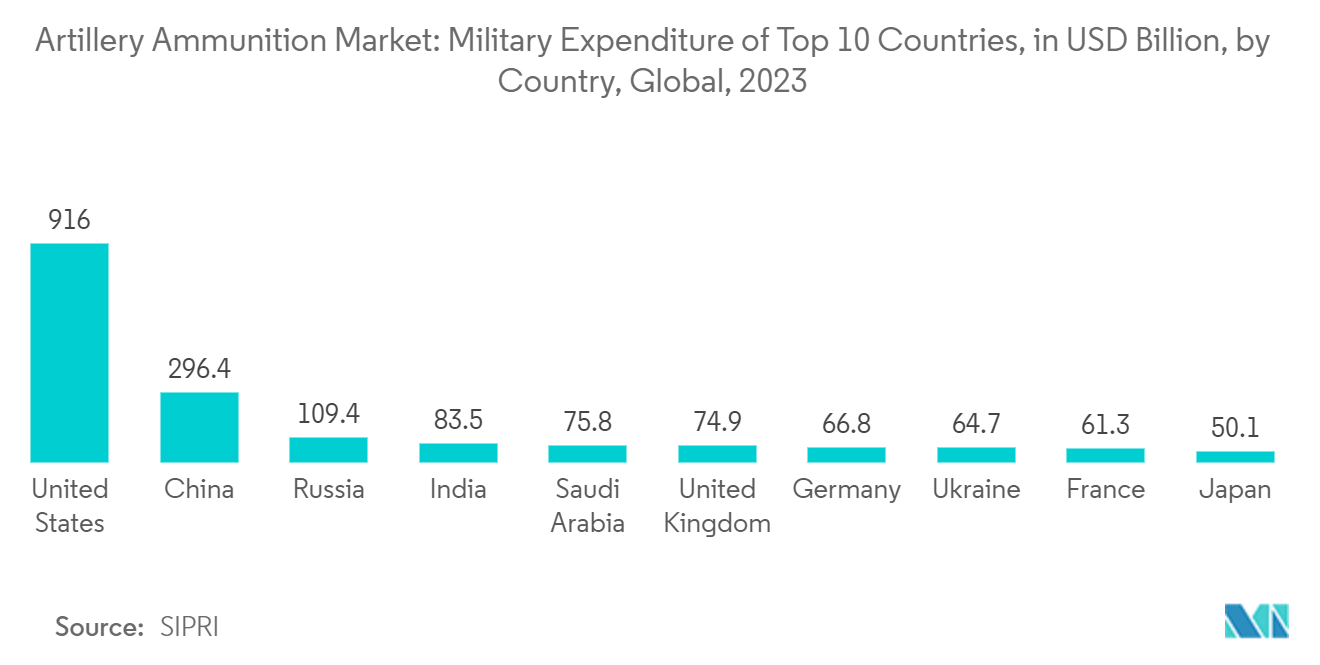Market Trends of Artillery Ammunition Industry
120mm & Above Segment Anticipated to Witness Highest Growth During the Forecast Period
The segment for artillery ammunition of 120mm and above is poised for substantial growth during the forecast period. Key drivers of this expansion include heightened defense spending by multiple nations, a push for more advanced artillery capabilities, and a global trend toward bolstering defense mechanisms. Furthermore, the integration of cutting-edge technology in ammunition development promises to enhance artillery systems' range, lethality, and precision in the foreseeable future.
Major players in the market are heavily investing in R&D for advanced artillery ammunition, signaling a robust focus on the 120 mm and above segment. As a testament to this trend, in April 2023, Switzerland unveiled its intent to bolster its artillery capabilities. They announced the acquisition of an additional batch of 120mm mortar systems, specifically tailored for the General Dynamics European Land Systems Piranha IV 8x8 armored vehicle. Further solidifying this commitment, the Swiss Federal Office for Armaments inked a deal with GDELS-Mowag, securing 16 more Mörser 16 120mm mortar systems units.
In July 2024, Elbit Systems Ltd. secured a USD 220 million contract from the Israel Ministry of Defense for its "Iron Sting" precision-guided mortar munitions. Designed for 120mm mortars, these munitions utilize advanced GPS and laser guidance technologies, achieving high-precision targeting capabilities up to 10 kilometers. The Iron Sting is equipped with a sophisticated multi-mode fuze system, featuring Point Detonation (PD), Point Detonation Delay (PDD), and Proximity Sensor (PRX) functionalities. This two-year upgrade aims to bolster the ground combat effectiveness and accuracy of the Israeli Defense Forces. In February 2023, Ukraine's state arms company announced a joint production of artillery shells with a NATO member from Central Europe, signaling intentions to collaborate on developing and producing other arms and military hardware. Additionally, as tensions escalated in the Russia-Ukraine conflict, Ukroboronprom commenced production of 120-mm mortar rounds in Ukraine.
Thus, the advancements in terms of research and development and production of advanced 120mm and above artillery ammunition by various key players in the market will lead to the 120mm and above segment witnessing significant growth in the market during the forecast period.

Asia-Pacific to Witness Highest Growth During the Forecast Period
Regional security threats, including territorial disputes and geopolitical tensions, are escalating in Asia. In response, nations are intensifying their focus on bolstering defense capabilities, leading to a surge in demand for artillery ammunition. Countries like China, India, and South Korea are channeling investments into advanced artillery systems, viewing them as deterrents against potential threats. This urgency to uphold a formidable defense posture is driving the acquisition of high-caliber artillery munitions, a trend poised to sustain the region's artillery ammunition market growth.
Numerous nations in the Asia Pacific are modernizing their military forces. They're phasing out older artillery systems in favor of advanced models, which demand compatible ammunition. This modernization effort addresses aging equipment and aims to integrate cutting-edge technology for enhanced combat effectiveness. As nations pivot towards sophisticated artillery solutions—like self-propelled howitzers and rocket-assisted projectiles—the demand for specialized ammunition rises, fueling market expansion.
Multinational defense exercises and alliances in the Asia Pacific cultivate a collaborative military training environment. These joint exercises often spotlight artillery's pivotal role in achieving tactical goals, amplifying the demand for artillery ammunition. Participating nations are thus motivated to bolster their artillery ammunition reserves, ensuring they're well-equipped for both training and operational demands, further propelling market growth.
Across the Asia Pacific, defense budgets are witnessing significant boosts, acting as a primary catalyst for the artillery ammunition market. Governments are channeling these funds into defense equipment acquisitions, artillery ammunition included, as part of their national security strategies. This financial commitment not only facilitates direct ammunition purchases but also champions domestic production, nurturing a vibrant defense industrial base in the region.
In January 2023, the Ethiopia government purchased 32 SH-15 (PCL-181) self-propelled howitzers from China. The PCL-181 is a truck-mounted, 155mm self-propelled howitzer used by China’s People’s Liberation Army (PLA) Ground Force. These howitzers are light enough to be airlifted by most medium transport aircraft, including C-295, C-130, and Y-9, making it a more flexible option for Ethiopia’s rapid reaction units. PCL-181) self-propelled howitzers are compatible with all standard 155mm NATO ammunition and indigenous ammunition developed by China North Industries Corporation (NORINCO).


